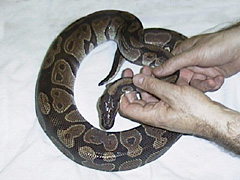Difference between revisions of "Royal Python"
Jump to navigation
Jump to search
| (6 intermediate revisions by 3 users not shown) | |||
| Line 1: | Line 1: | ||
| − | {{ | + | {{unfinished}} |
| − | [[Image: | + | [[Image:ROYAL_PYTHON_240x180_border.jpg|250px|thumb|right|'''Royal python''' ©RVC and its licensors, Peer Zwart and Fredric Frye. All rights reserved]] |
==Introduction== | ==Introduction== | ||
| − | The royal or ball python (''Python regius'') is of the family | + | The royal or ball python (''Python regius'') is of the family Boidea. |
==Morphology== | ==Morphology== | ||
Royal pythons grow to over one metre in length and have a stumpy tail. They are irregularly darkish brown to black marked with large, irregular blotches (that have the appearance of aliens!). This colouring allows camouflage in dark soil and grass. Their life span in captivity may be up to 18 years. | Royal pythons grow to over one metre in length and have a stumpy tail. They are irregularly darkish brown to black marked with large, irregular blotches (that have the appearance of aliens!). This colouring allows camouflage in dark soil and grass. Their life span in captivity may be up to 18 years. | ||
==Free-Living== | ==Free-Living== | ||
*Distribution and habitat – Royal pythons come from the grasslands of western Africa | *Distribution and habitat – Royal pythons come from the grasslands of western Africa | ||
| − | * | + | *Diet – Royal pythons primarily hunt and constrict grassland rodents. |
==Captivity== | ==Captivity== | ||
*Cage – Royal pythons are basically terrestrial but will climb branches. | *Cage – Royal pythons are basically terrestrial but will climb branches. | ||
*Temperature and humidity - Environmental requirements include a temperature range of 25-30°C and a humidity of 30-70%. | *Temperature and humidity - Environmental requirements include a temperature range of 25-30°C and a humidity of 30-70%. | ||
| − | * | + | *Diet – Royal pythons will eat rodents in captivity. They normally fast from November/December for three to five months until February/March. |
| − | * | + | *Reproduction – Royal pythons are oviparous. The eggs have an incubation of about 75-80 days and the female coils around them |
*Veterinary considerations – They are not a particularly good pet because of problems with anorexia. | *Veterinary considerations – They are not a particularly good pet because of problems with anorexia. | ||
| − | |||
| − | |||
| − | |||
| − | |||
| − | |||
| − | |||
| − | |||
| − | |||
| − | |||
| − | |||
| − | |||
| − | |||
[[Category:Snake Species]] | [[Category:Snake Species]] | ||
| − | |||
Revision as of 13:59, 8 April 2010
| This article is still under construction. |
Introduction
The royal or ball python (Python regius) is of the family Boidea.
Morphology
Royal pythons grow to over one metre in length and have a stumpy tail. They are irregularly darkish brown to black marked with large, irregular blotches (that have the appearance of aliens!). This colouring allows camouflage in dark soil and grass. Their life span in captivity may be up to 18 years.
Free-Living
- Distribution and habitat – Royal pythons come from the grasslands of western Africa
- Diet – Royal pythons primarily hunt and constrict grassland rodents.
Captivity
- Cage – Royal pythons are basically terrestrial but will climb branches.
- Temperature and humidity - Environmental requirements include a temperature range of 25-30°C and a humidity of 30-70%.
- Diet – Royal pythons will eat rodents in captivity. They normally fast from November/December for three to five months until February/March.
- Reproduction – Royal pythons are oviparous. The eggs have an incubation of about 75-80 days and the female coils around them
- Veterinary considerations – They are not a particularly good pet because of problems with anorexia.
